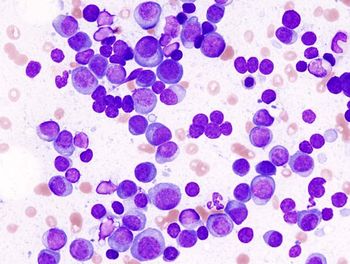
- Oncology Vol 28 No 1S
- Volume 28
- Issue 1S
(P098) Dose-Painting Technique in SBRT of Hepatocellular Carcinoma of Unfavorable Locations: Feasibility and Outcomes
Stereotactic body radiotherapy (SBRT) is increasingly utilized for the treatment of inoperable hepatocellular carcinoma (HCC) alone or in combination with other local treatment modalities. However, proximity to bowel often precludes the ability to deliver the full prescription dose to the planning target volume (PTV). In this study, we evaluate our experience using the technique of radiation therapy (RT)–dose-painting (DPRT) to decrease the dose received to critical structures with the PTV.
Benjamin K. Hinton, MD, Craig Baden, MD, MPH, Sui Shen, PhD, Kimberly Dempsey, CMD, Nicole A. Safiano, BS, Rojymon Jacob, MD; University of Alabama at Birmingham
Introduction: Stereotactic body radiotherapy (SBRT) is increasingly utilized for the treatment of inoperable hepatocellular carcinoma (HCC) alone or in combination with other local treatment modalities. However, proximity to bowel often precludes the ability to deliver the full prescription dose to the planning target volume (PTV). In this study, we evaluate our experience using the technique of radiation therapy (RT)–dose-painting (DPRT) to decrease the dose received to critical structures with the PTV.
Materials and Methods: Twenty-nine patients with inoperable HCC treated in our institution using SBRT between April 2009 and November 2012 were analyzed to determine acute toxicity, local control (LC), and feasibility of delivery of SBRT. All patients were simulated and planned for SBRT in a standard fashion. Gross tumor volume (GTV) encompassed all visible disease on contrasted computed tomography (CT) simulation. Clinical target volume (CTV) included an additional 4 mm; PTV was constructed by adding a 5-mm geometric uncertainty margin around the CTV. All but three patients were simulated and treated with respiratory gating, and all had cone beam CT for image guidance. In seven patients, the PTV extended into the small bowel, stomach, or esophagus. The gastrointestinal structures within the PTV were contoured with an additional 5-mm margin within the PTV to create the dose-painting PTV (DPTV). Twenty-two patients did not require any modification to the PTV. Prescription dose was 45 Gy or 60 Gy in three fractions to the PTV in all patients. Dose to the PTV was limited to < 21 Gy in three fractions. All patients were analyzed for LC and distant liver control (DLC). Statistical significance was tested with the Wilcoxon rank-sum test. Treatment plans of seven patients who were planned using DPTV were analyzed by comparing dose-volume parameters when planned with or without DPTV to illustrate the impact of the dose-painting strategy. The gastrointestinal data points that were analyzed were: V20-Gy (volume receiving 20 Gy), V22-Gy (volume receiving 22 Gy), and Dmax (maximum point dose).
Results: Use of DPRT helped to restrict gastrointestinal doses to within tolerable limits. The acute toxicity rates were not statistically different between the groups of patients planned with or without DPRT (no grade 2 or higher toxicities). No differences were noted in outcomes between patients treated with or without DPRT. Disease-related outcomes for patients receiving DPRT (n = 7) vs full-dose RT (n = 22) were as follows: LC 100% vs 85.7% (P = NS) and DLC 62.5% vs 66.7% (P = NS). On average, DPRT reduced V20-Gy, V22-Gy, and Dmax by 9.7 cc (6.8%), 10.7 cc (6.0%), and 17.0 Gy, respectively.
Conclusions: DPRT allowed for significant reduction in gastrointestinal dose during SBRT planning. Utilization of DPRT to spare gastrointestinal structures did not adversely impact local tumor control.
Articles in this issue
Newsletter
Stay up to date on recent advances in the multidisciplinary approach to cancer.

















































































